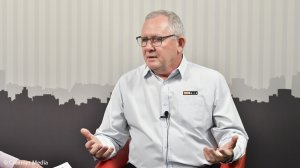ESG targets are prioritising the need for mining tyre circularity

Kal Tire VP Southern Africa John Martin interviewed by Mining Weekly's Martin Creamer. Video: Creamer Media's Nicholas Boyd.
JOHANNESBURG (miningweekly.com) – Stockpiles of mining tyres are beginning to weigh heavily on the environmental, social and governance (ESG) targets of mining companies.
Large tyre accumulations visible at some mining operations point to the need for the circular economy to be prioritised.
Extending the life of tyres for as long as possible in mining conditions and then providing recycling options at the tyres’ end-of-life is ESG in action.
Ideally, the recycling should enable old waste tyre material to become an integral part of new tyre production.
At the forefront of taking tyre circularity to the highest possible level through thermal conversion is mining tyre group Kal Tire, which has been advancing its intellectual property (IP) of thermal conversion intensively in recent years.
Importantly, thermal conversion of off-the-road (OTR) tyres is able to recover large volumes of fuel oil, major steel tonnages and bountiful carbon black for reuse in new tyre production at a time when mining jurisdictions the world over will likely require some form of mine tyre circularity in the near future.
The company’s focal point is its facility in northern Chile, where end-of-life ultra-class tyres are converted to their base elements of carbon black, oil and steel so that these recovered materials can be reused in new products instead of raw materials.
Set up in response to end-of-life tyre legislation in Chile, the facility’s thermal conversion processes use heat and friction to induce a process that sees virtually 100% of the tyre reused.
To find out more, Mining Weekly put these questions to Kal Tire VP Southern Africa John Martin. (Also watch attached Creamer Media video.)
Are mining tyres being recycled now?
On a global scale, to a certain extent, they are. There are various options that are being used right now, for example, shredding of tyres, or something called devulcanisation or creating rubber crumb. But let’s say from a Kal Tire perspective, that's probably more repurposing of the tyre than recycling. Our thermal conversion solution is, for us, probably the most self-contained recycling facility available in the world, designed specifically for mining tyres. In South Africa, the Waste Bureau is responsible for the abatement of tyres, but we certainly wish that could be expanded now to include the mining side of it.
Why would a company like Kal Tire want to invest in the R&D to create mining tyre recycling technology?
First of all, I think it's the right thing to do, and secondly, it was identified as a requirement, probably close to ten years ago, that this is something that the industry needs, primarily driven out of Chile, where legislation then forced, if I can use the term forced, the industry to start with the recycling process. Kal Tire saw that as an opportunity to extend the services, the quality of the services, and obviously these innovations that we bring to the industry. It's a long-term project, of course, and it's not just Chile that requires it. Essentially all mining jurisdictions around the world will require some form of tyre recycling in the future.
How does thermal conversion OTR tyre recycling work?
In general, it's a relatively simple process, but it's quite complex in the way that it culminates in the technology that's inside the facility. We simply collect the tyres from the mine. At that point, we take ownership and custody of the tyre. It's documented from its serial number, and we can then provide evidence to the mine owners that their tyres have been recycled in an ethical and sustainable manner. It gets delivered to the facility, we size it, we clean it. It gets put into the chamber, goes through a pyrolysis-type process, and we generate products at the end that can then go back into the circular economy – simply things like oil, steel, carbon black, et cetera.
What can South Africa learn about how this technology and legislation was successfully adopted in Chile?
The legislation was, of course, key. The legislation in Chile is solid. We know who is responsible for the recycling of the tyres. In South Africa, the legislation needs to be firmed up. At the moment, the Waste Bureau is responsible for tyre abatement in this country. We believe and understand that there's some form of recycling going on, or repurposing of tyres, but it’s really restricted to small tyres. So, we need cooperation from government. We have, as end-users, already paid R2.30 per kilogram of every single tyre that gets manufactured, that gets imported into this country. So, we have already paid some money to government for the recycling, or for the abatement, of tyres, all tyres, mining tyres included. To move this forward, we certainly need help from government, we need participation from the operations, communities, investors. All the components are there. We just need to get everybody to get together to be able to get this moving.
You spoke about size. Just give us some idea of the size of your tyres.
The biggest ones are probably in the order of five to six tons and we process about 20 t of tyre at a time. At the end of the process, we’re generating in the order of six and a half thousand litres of fuel oil. There's four tons of steel that comes out of it, and about eight tons of carbon black. All these products, again, feed back into the circular economy. Of particular interest to the global economy is the carbon black or carbon ash, as it is when it comes out of the reactors. We're in the process of developing technology now to clean that up to a purification level that would be acceptable to all the tyre manufacturers, where the carbon can then be reused to manufacture new tyres. If you're talking about the full circular economy, you can imagine that an old waste tyre can generate a brand new tyre simply by the products that come out of the process and get fed back into the creation of new tyres, so probably the circular economy to the nth degree. It’s old tyres creating new tyres, and that's really what we wanted out of this process.
What happens to end-of-life mining tyres here in South Africa?
Well, previously, mining companies generally buried those tyres in waste dumps, and in many countries, and certainly in Africa, that's still the practice. First of all, it's illegal now to do that, which is a really good thing. But all these really large tyres, at the moment, are simply being stored on a mine site. One can go into Google Earth and have a look at some of the big operations, and you'll see these enormous mountains of tyres that are lying there waiting for some form of processing to get rid of these tyres. It is creating environmental hazards. It is a challenge to many of the mining operations in terms of the ESG targets, because recycling is extremely important for all the mining companies these days, it’s sort of on everybody's lips. If we can get the recycling of these tyres moving in South Africa, it can certainly contribute enormously to those goals that our customers have in terms of their ESGs. There's certainly significant opportunities, should we all be able to get together, and I think everybody can benefit.
Are there any final thoughts you want to put across?
The time right now is important. All the components, I think, are in place. The financing of the recycling process can, to a large degree, be taken from, for example, remediation budgets from customers. That doesn't necessarily affect their daily operational P and L's. We have already paid money to government for recycling, so there's a financial component that needs to come from government. There may be some funding shortage at the end of the day, but there's willingness, I think, from industry, there's willingness from private investors, we hope there's willingness from government, to get together and we can create a solution. Technology exists and the customer’s drive and commitment to ESG is there, so all the components are there and I think it's really just time we find each other.
Article Enquiry
Email Article
Save Article
Feedback
To advertise email advertising@creamermedia.co.za or click here
Press Office
Announcements
What's On
Subscribe to improve your user experience...
Option 1 (equivalent of R125 a month):
Receive a weekly copy of Creamer Media's Engineering News & Mining Weekly magazine
(print copy for those in South Africa and e-magazine for those outside of South Africa)
Receive daily email newsletters
Access to full search results
Access archive of magazine back copies
Access to Projects in Progress
Access to ONE Research Report of your choice in PDF format
Option 2 (equivalent of R375 a month):
All benefits from Option 1
PLUS
Access to Creamer Media's Research Channel Africa for ALL Research Reports, in PDF format, on various industrial and mining sectors
including Electricity; Water; Energy Transition; Hydrogen; Roads, Rail and Ports; Coal; Gold; Platinum; Battery Metals; etc.
Already a subscriber?
Forgotten your password?
Receive weekly copy of Creamer Media's Engineering News & Mining Weekly magazine (print copy for those in South Africa and e-magazine for those outside of South Africa)
➕
Recieve daily email newsletters
➕
Access to full search results
➕
Access archive of magazine back copies
➕
Access to Projects in Progress
➕
Access to ONE Research Report of your choice in PDF format
RESEARCH CHANNEL AFRICA
R4500 (equivalent of R375 a month)
SUBSCRIBEAll benefits from Option 1
➕
Access to Creamer Media's Research Channel Africa for ALL Research Reports on various industrial and mining sectors, in PDF format, including on:
Electricity
➕
Water
➕
Energy Transition
➕
Hydrogen
➕
Roads, Rail and Ports
➕
Coal
➕
Gold
➕
Platinum
➕
Battery Metals
➕
etc.
Receive all benefits from Option 1 or Option 2 delivered to numerous people at your company
➕
Multiple User names and Passwords for simultaneous log-ins
➕
Intranet integration access to all in your organisation















